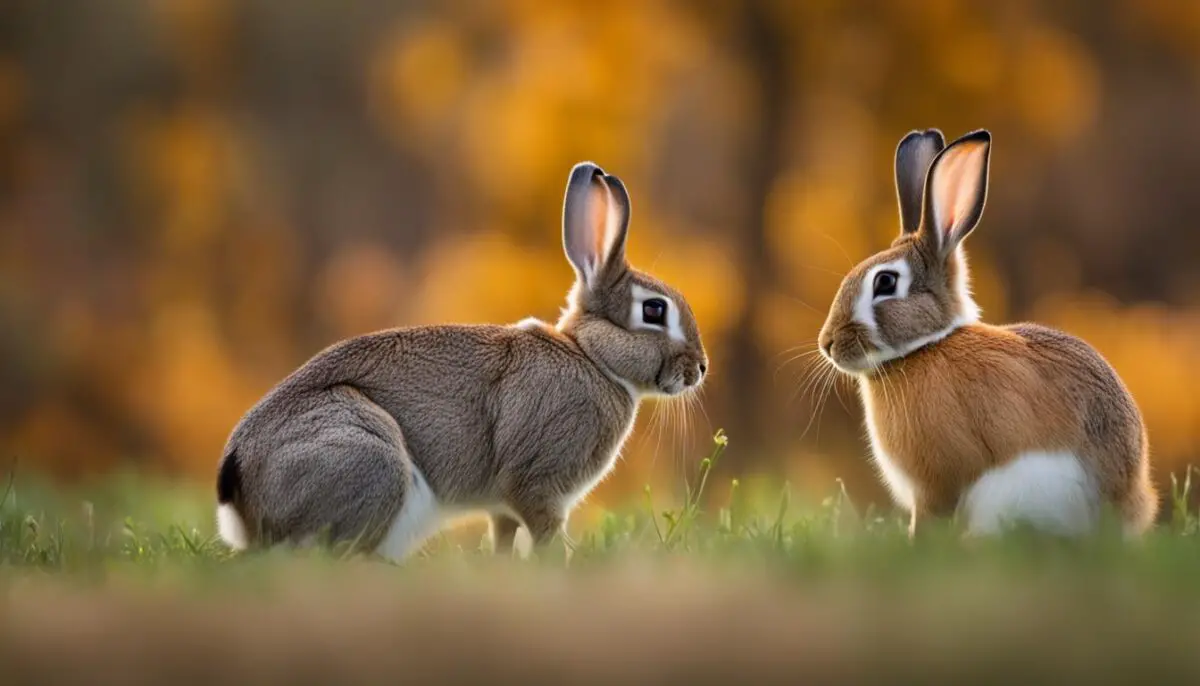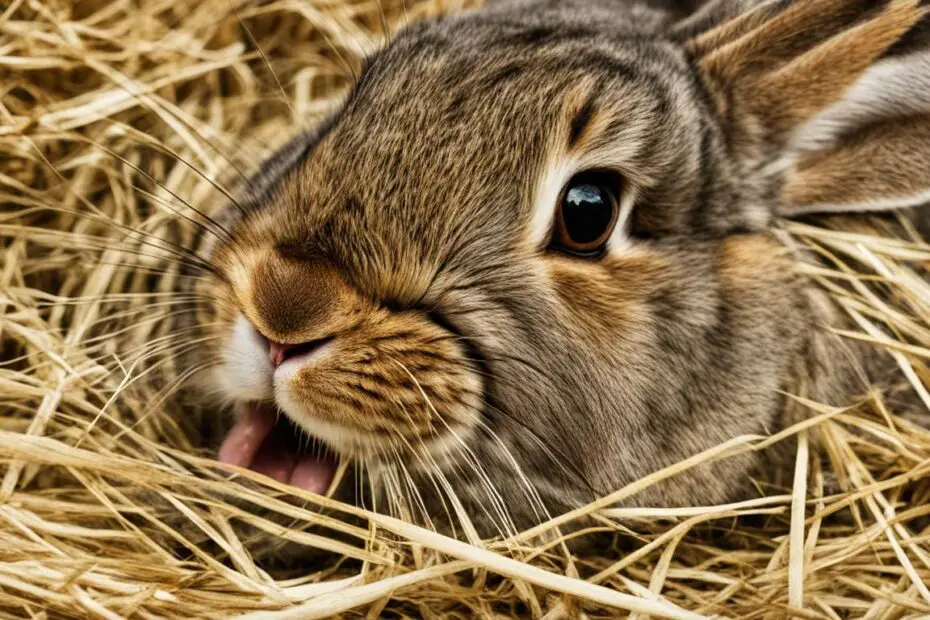Rabbits may seem like quiet pets, but they actually have a variety of noises they use for communication. Understanding these rabbit noises can help you decipher what your bunny is trying to tell you. From purring and honking to buzzing and clucking, rabbits have specific sounds for different occasions. They can also make warning sounds like hissing and growling, as well as distress signals like screaming. By paying attention to these noises, you can better understand your rabbit’s emotions and strengthen the bond between you.
Key Takeaways:
- Rabbits have a variety of noises they use for communication.
- Understanding rabbit noises can help you better understand your pet’s emotions.
- Rabbits make different sounds for happy occasions, warning signs, and distress signals.
- Paying attention to these noises can strengthen the bond between you and your rabbit.
- By observing both rabbit noises and body language, you can develop a deeper connection with your pet.
Happy Rabbit Noises
When your rabbit is feeling content and happy, they may express their joy through various noises. These happy rabbit noises can provide valuable insights into your bunny’s emotions and well-being. Let’s explore some of the common sounds that indicate a happy rabbit.
Clucking or Chirruping:
One of the delightful sounds you may hear from a happy rabbit is clucking or chirruping. This soft and gentle sound is often associated with satisfaction and is frequently heard when rabbits are feeding or peacefully napping. It’s a gentle reminder that your bunny is in a state of bliss.
Buzzing or Humming:
Male rabbits that have not been neutered may emit a buzzing or humming sound when they are in the mood for love. This unique noise is their way of expressing their amorous desires. It’s a sign of their affectionate and playful nature as they navigate their mating dance.
Honking or Grunting:
If you observe your rabbit honking or grunting, it’s a serious amorous sign. Accompanied by circling, this behavior signifies that the mating ritual has begun. It’s a clear indication that your bunny is feeling content and ready to engage in a romantic rendezvous.
Purring:
When your rabbit purrs, it’s an endearing display of contentment. The purring sound made by rabbits is softer than that of a cat. They achieve this sound by rubbing their teeth together. Purring is a sign that your bunny is feeling happy and relaxed in their environment.
“The gentle clucking and soothing purring of a happy rabbit create a harmonious symphony that warms the hearts of rabbit owners.”

Another distress signal that requires attention is wheezing or sniffling. However, it is essential to distinguish this from a normal sigh. If your rabbit is making wheezing or sniffling sounds with difficulty breathing, it indicates respiratory issues. Respiratory problems in rabbits can escalate rapidly and may lead to more severe illnesses if left untreated. Therefore, it is vital to contact your veterinarian immediately to ensure the well-being of your rabbit.
If your rabbit emits a scream or a loud squeal, it is a chilling sound that should be taken very seriously. Rabbits typically make these distress signals only when they feel under direct threat or are experiencing intense pain. If you hear your rabbit screaming or loudly squealing, it indicates an emergency situation, and immediate medical attention is crucial to alleviate their distress and provide necessary care.
Recognizing and responding promptly to these distress signals is essential for maintaining the health and well-being of your rabbit. By understanding their communication cues, you can ensure that your furry companion receives the appropriate care and support in times of distress.
Understanding Rabbit Communication
While rabbit noises are an essential part of their communication, it’s important to remember that rabbits also rely heavily on body language to convey their emotions. By understanding both their noises and body language, you can develop a deeper connection with your rabbit and better understand their needs and emotions. The more you listen and observe, the stronger your human-pet bond will become.
The Role of Body Language in Rabbit Communication
Rabbits use various body movements and postures to express their feelings and intentions. By paying attention to their body language, you can decipher their emotions more effectively. Here are some common examples:
- Ears: When a rabbit’s ears are standing up and facing forward, it signifies alertness and curiosity. If their ears are flattened against their body, it indicates fear or submission.
- Body Position: A relaxed and stretched-out posture implies contentment, while a huddled posture indicates fear or discomfort.
- Tail: A raised and twitching tail can signify excitement or curiosity, while a tucked tail suggests fear or stress.
Understanding these body language cues along with rabbit noises will allow you to gauge your pet’s overall state of mind and respond accordingly.
Interpreting Rabbit Noises
Rabbit noises can provide valuable insights into their emotions and intentions. Here are some common types of rabbit noises:
- Clucking or Chirruping: This soft and gentle sound typically indicates satisfaction or contentment. It is often heard when rabbits are feeding or sleeping.
- Honking or Grunting: These deeper sounds often accompany circling behavior and indicate that the rabbit is in a mating mood.
- Purring: Similar to a cat’s purr, rabbits purr when they are feeling content and at ease.
- Growling or Hissing: These warning sounds suggest that the rabbit is feeling threatened or agitated. It’s essential to give them space and avoid any sudden movements.
By paying attention to these noises and combining them with body language cues, you can gain a deeper understanding of your rabbit’s communication style.
Building a Strong Human-Pet Bond
Understanding rabbit communication is crucial for fostering a strong bond with your pet. By actively listening to their noises and observing their body language, you can respond to their needs effectively. This creates a sense of trust and builds a deeper connection with your rabbit.
The image below showcases a rabbit engaged in various communication behaviors:

| Rabbit Noises | Meaning |
|---|---|
| Clucking or Chirruping | Satisfaction or contentment |
| Honking or Grunting | Mating behavior |
| Purring | Content and at ease |
| Growling or Hissing | Threatened or agitated |
By developing your understanding of rabbit communication, you can strengthen the bond between you and your furry companion. Paying attention to their noises and body language allows you to respond appropriately and provide the care and companionship they need.
The Variety of Rabbit Sounds
Rabbits are not as silent as they may appear. They have a wide variety of sounds that they use to communicate their emotions and needs. By analyzing and interpreting these rabbit noises, you can gain a deeper understanding of what your furry friend is trying to convey.
Here are some examples of the sounds rabbits make:
- Clucking: A soft and gentle sound that indicates contentment and satisfaction. It is often heard when rabbits are feeding or sleeping.
- Honking: A more serious sound made by unaltered male rabbits when they are in the mood for love. It is often accompanied by circling and other mating behaviors.
- Purring: Similar to a cat’s purr, rabbits purr by rubbing their teeth together. It signifies contentment and relaxation.
- Growling: Can indicate both happiness and annoyance. It is important to observe other body language cues to distinguish the context.
- Hissing: A warning sound that rabbits use to signal danger or to establish boundaries. If a rabbit hisses at you, it’s best to respect their space.
Understanding these different rabbit sounds will enable you to better interpret your rabbit’s emotions and enhance your communication with them. By paying attention to their noises and observing their body language, you can deepen your bond and provide the best care for your furry companion.
Conclusion
Rabbits have a fascinating way of communicating through various sounds, offering valuable insights into their emotions and needs. Understanding the significance of these rabbit noises, ranging from joyful clucking and purring to cautionary growling and hissing, allows us to connect more deeply with our furry friends. Moreover, observing their body language complements our comprehension of their behavior.
Developing a strong bond with your rabbit relies on interpreting their communication, enabling you to provide optimal care and nurture a fulfilling relationship. By familiarizing yourself with rabbit communication sounds, such as clucking and purring, you can gauge their contentment and happiness. Conversely, growling and hissing serve as warning signs, indicating discomfort or potential danger.
To truly understand your rabbit, it is crucial to pay attention to their body language in conjunction with their vocalizations. This comprehensive approach enhances our understanding of their needs and emotions, fostering a harmonious human-pet bond. By appreciating the nuances of rabbit communication, we can provide the love and care that our rabbits deserve.
FAQ
Do rabbits make noise?
Yes, rabbits make a variety of noises to communicate with each other and with humans. These noises can range from happy sounds to warning signals and distress signals.
What are the happy noises that rabbits make?
The happy noises made by rabbits include clucking or chirruping, buzzing or humming, honking or grunting, and purring. These noises indicate contentment and satisfaction.
What are the warning sounds that rabbits make?
Rabbits make various warning sounds such as sighing, whining or whimpering, snorting, growling, muttering, and hissing. These noises are a way for rabbits to express unhappiness or irritation.
What are the distress signals that rabbits make?
Rabbits may make distress signals when they are feeling afraid, in danger, or in severe pain. These signals include teeth grinding, wheezing or sniffling, and screaming or loud squealing. Prompt attention and action are required when these distress signals are observed.
How can I understand rabbit communication?
To understand rabbit communication, it is important to pay attention to both their noises and body language. By observing their sounds and behaviors, you can develop a deeper connection with your rabbit and better understand their emotions and needs.
What should I do to interpret rabbit sounds?
To interpret rabbit sounds, it is necessary to analyze the variety of noises they make. By understanding the meanings behind these sounds, you can gain valuable insights into your rabbit’s emotions and behaviors.
How can I bond with my rabbit through communication?
Understanding rabbit communication is a key factor in building a strong human-pet bond. By listening and observing your rabbit’s noises and body language, you can provide the best care and nurture your relationship with your furry friend.

